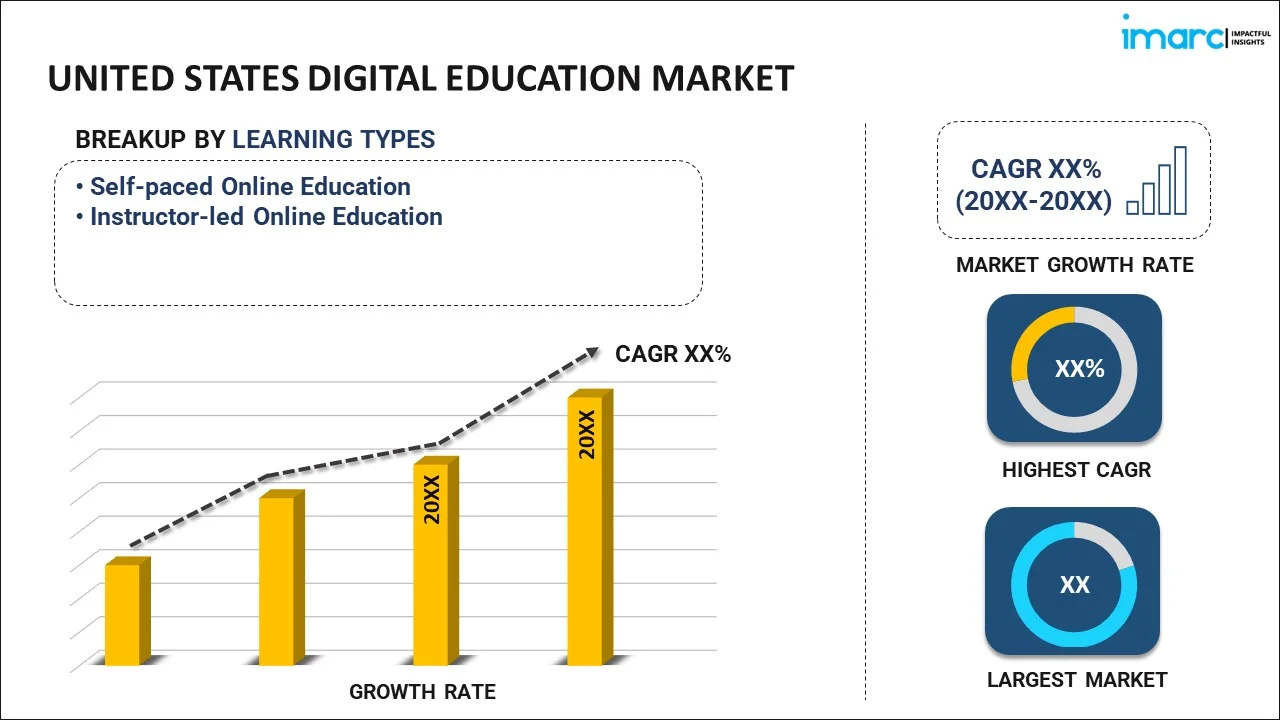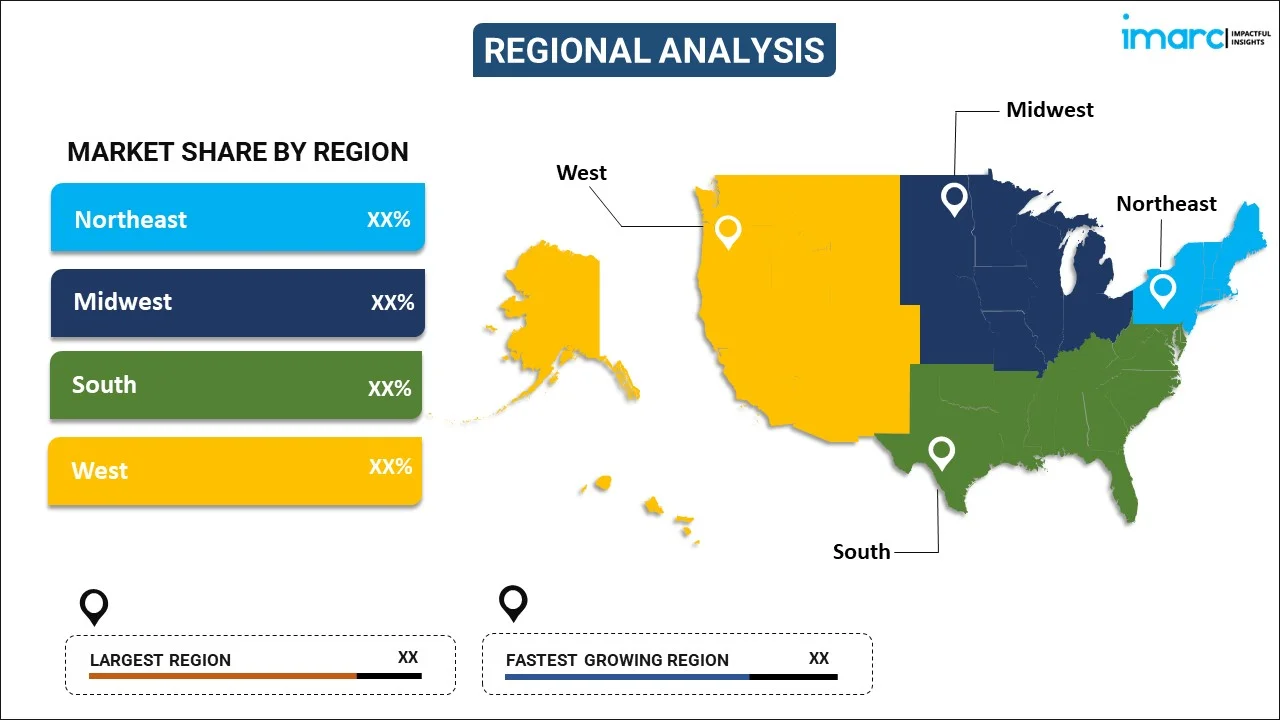
United States Digital Education Market Report by Learning Type (Self-paced Online Education, Instructor-led Online Education), Course Type (Science, Technology, Engineering, and Mathematics (STEM), Business Management, and Others), End User (Academic Institutions and Individuals, Enterprises), and Region 2024-2032
Market Overview:
United States digital education market size reached US$ 4.8 Billion in 2023. Looking forward, IMARC Group expects the market to reach US$ 10.7 Billion by 2032, exhibiting a growth rate (CAGR) of 29.10% during 2024-2032. The growing demand for online courses and certification programs, rising integration of big data to gain insights into student learning patterns, and increasing incorporation of elements like points, badges, and leaderboards in educational content represent some of the key factors driving the market.
|
Report Attribute
|
Key Statistics
|
|---|---|
|
Base Year
|
2023 |
|
Forecast Years
|
2024-2032 |
|
Historical Years
|
2018-2023
|
| Market Size in 2023 | US$ 4.8 Billion |
| Market Forecast in 2032 | US$ 10.7 Billion |
| Market Growth Rate (2024-2032) | 29.10% |
Digital education, also known as eLearning, is the utilization of digital technology to facilitate the learning and teaching process. It encompasses the creation, distribution, and consumption of educational content through digital means, such as computers, tablets, and smartphones. It is manufactured through the development of online courses, multimedia content, and interactive learning materials. It is categorized into synchronous education, where learners and instructors interact in real-time. It is also available as asynchronous models, where learners access pre-recorded materials at their own pace. It allows learners to access educational resources from anywhere at any time, breaking down geographical barriers. It offers personalized learning experiences, catering to individual needs and pacing. It also reduces the environmental impact associated with traditional printed materials. It empowers self-directed learning, promoting critical thinking and problem-solving skills. It is used in various sectors, including primary education, higher education, corporate training, and skill development.
United States Digital Education Market Trends:
At present, the rising demand for online courses, certification programs, and skill development modules among learners represents one of the key factors impelling the growth of market in the United States. Additionally, increasing innovations in artificial intelligence (AI) and machine learning (ML) are facilitating personalized learning experiences, adaptive learning platforms, and sophisticated learning management systems (LMS). The integration of virtual reality (VR) and augmented reality (AR) into educational content for creating immersive and interactive learning environments is supporting the market growth in the country. Besides this, the growing shift towards learner-centric approaches is encouraging the adoption of digital education as it facilitates personalized learning experiences, where content and pace can be tailored to individual needs. This shift is supported by data analytics, which provides insights into learner behavior and preferences, allowing for more effective curriculum design and pedagogical strategies. Moreover, rising partnerships between educational institutions and technology companies are creating innovative educational solutions that combine pedagogical expertise with cutting-edge technology. In addition, the increasing integration of big data and analytics into digital education to gain insights into student learning patterns, engagement levels, and educational outcomes is contributing to the market growth in the country. This data-driven approach enables the customization of learning experiences and aids in the development of more effective educational content and strategies. Furthermore, the growing incorporation of elements like points, badges, and leaderboards in educational content to make it more engaging and motivating for students is offering a favorable market outlook. This approach also improves student engagement, motivation, and learning outcomes, especially in subjects that students traditionally find challenging or uninteresting.
United States Digital Education Market Segmentation:
IMARC Group provides an analysis of the key trends in each segment of the market, along with forecasts at the country level for 2024-2032. Our report has categorized the market based on learning type, course type, and end user.
Learning Type Insights:

- Self-paced Online Education
- Instructor-led Online Education
The report has provided a detailed breakup and analysis of the market based on the learning type. This includes self-paced online education and instructor-led online education.
Course Type Insights:
- Science, Technology, Engineering, and Mathematics (STEM)
- Business Management
- Others
A detailed breakup and analysis of the market based on the course type have also been provided in the report. This includes science, technology, engineering, and mathematics (STEM), business management, and others.
End User Insights:
- Academic Institutions and Individuals
- Enterprises
The report has provided a detailed breakup and analysis of the market based on the end user. This includes academic institutions and individuals and enterprises.
Regional Insights:

- Northeast
- Midwest
- South
- West
The report has also provided a comprehensive analysis of all the major regional markets, which include the Northeast, Midwest, South, and West.
Competitive Landscape:
The market research report has also provided a comprehensive analysis of the competitive landscape in the market. Competitive analysis such as market structure, key player positioning, top winning strategies, competitive dashboard, and company evaluation quadrant has been covered in the report. Also, detailed profiles of all major companies have been provided.
United States Digital Education Market Report Coverage:
| Report Features | Details |
|---|---|
| Base Year of the Analysis | 2023 |
| Historical Period | 2018-2023 |
| Forecast Period | 2024-2032 |
| Units | US$ Billion |
| Scope of the Report | Exploration of Historical and Forecast Trends, Industry Catalysts and Challenges, Segment-Wise Historical and Predictive Market Assessment:
|
| Learning Types Covered | Self-paced Online Education, Instructor-led Online Education |
| Course Types Covered | Science, Technology, Engineering, and Mathematics (STEM), Business Management, Others |
| End Users Covered | Academic Institutions and Individuals, Enterprises |
| Regions Covered | Northeast, Midwest, South, West |
| Customization Scope | 10% Free Customization |
| Report Price and Purchase Option | Single User License: US$ 3699 Five User License: US$ 4699 Corporate License: US$ 5699 |
| Post-Sale Analyst Support | 10-12 Weeks |
| Delivery Format | PDF and Excel through Email (We can also provide the editable version of the report in PPT/Word format on special request) |
Key Questions Answered in This Report:
- How has the United States digital education market performed so far and how will it perform in the coming years?
- What has been the impact of COVID-19 on the United States digital education market?
- What is the breakup of the United States digital education market on the basis of learning type?
- What is the breakup of the United States digital education market on the basis of course type?
- What is the breakup of the United States digital education market on the basis of end user?
- What are the various stages in the value chain of the United States digital education market?
- What are the key driving factors and challenges in the United States digital education?
- What is the structure of the United States digital education market and who are the key players?
- What is the degree of competition in the United States digital education market?
Key Benefits for Stakeholders:
- IMARC’s industry report offers a comprehensive quantitative analysis of various market segments, historical and current market trends, market forecasts, and dynamics of the United States digital education market from 2018-2032.
- The research report provides the latest information on the market drivers, challenges, and opportunities in the United States digital education market.
- Porter's five forces analysis assist stakeholders in assessing the impact of new entrants, competitive rivalry, supplier power, buyer power, and the threat of substitution. It helps stakeholders to analyze the level of competition within the United States digital education industry and its attractiveness.
- A competitive landscape allows stakeholders to understand their competitive environment and provides an insight into the current positions of key players in the market.
Need more help?
- Speak to our experienced analysts for insights on the current market scenarios.
- Include additional segments and countries to customize the report as per your requirement.
- Gain an unparalleled competitive advantage in your domain by understanding how to utilize the report and positively impacting your operations and revenue.
- For further assistance, please connect with our analysts.
 Inquire Before Buying
Inquire Before Buying
 Speak to an Analyst
Speak to an Analyst
 Request Brochure
Request Brochure
 Request Customization
Request Customization




.webp)




.webp)












